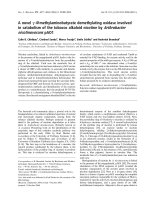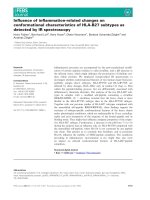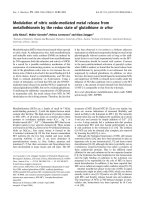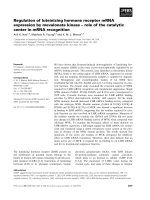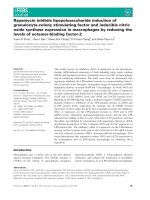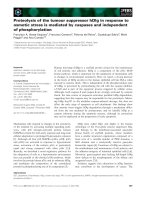Floral manipulation in mangos by tomdavenport in department of horticulture, university of florida
Bạn đang xem bản rút gọn của tài liệu. Xem và tải ngay bản đầy đủ của tài liệu tại đây (179.69 KB, 7 trang )
FLORAL MANIPULATION
IN
MANGOS
Tom Davenport
Department of Horticulture
University
of
Florida
My research on mango flowering began about
five years ago.
By
that
time, smudging,
the
traditional Philippine use
of
smoke to promote
flowering,
had
given way to
the
more
convenient
and efficacious use
of
ethephon
(a
compound that
generates ethylene in plants) and potassium
nitrate sprays. Not only were mango trees in the
Philippines stimulated to flower out
of
season with
these treatments,
but
irregularly-bearing trees
could
be
stimulated to
bear
in most years.
The
connection between smoke (which contains
ethylene), ethylene generated from ethephon, and
flowering response led to the hypothesis
that
ethylene was
the
"hormone"
which induced trees
to flower.
Based on what we knew
at
the time, ethylene
was a potential factor in flowering.
In support
of
the hypothesis, we
had
observed epinasty, the
temporary turning-under
of
leaves, occurring in
leaves of flowering branches. Those involved in
ethylene physiology recognize epinasty as one
symptom of ethylene exposure, either
endogenously produced
or
exogenously applied as
a gas. Therefore, early in
our
experiments we
measured ethylene production in buds, leaves, and
developing panicles.
The
results
of
a number
of
experiments led us to
the
conclusion that
enhanced ethylene production does not seem to
be
involved in mango flowering.
We
found that floral
buds which should have
been
producing ethylene
were not producing significantly
more
than plant
parts at other stages
of
growth.
The
levels
of
ethylene observed in flowers were basically the
same as background levels.
We
applied ethylene in
the
form
of
ethephon, causing
the
tissues to
produce copious amounts
of
ethylene.
It
resulted
in no stimulation
of
flowering. Moreover,
potassium nitrate did not increase ethylene levels
or
stimulate flowering in either 'Tommy Atkins'
or
'Keitt' trees.
Potassium nitrate
(KN0
3
)
came into general
use in the Philippines in
the
1970s.
It
too was
speculated to stimulate flowering through a
wound-ethylene response.
It
now is widely used in
Mexico as well. Although responses may occur
at
concentrations ranging from 1 to 8 percent,
Mexican growers generally use 4 per.;ent
KN0
3
or
2 percent ammonium nitrate.
Leaf
tip burn
occurs in dry areas at these concentrations.
flowering response is cultivar-specific.
'Irwin', 'Carabao', and 'Manila', for
respond well.
Poly embryonic cultivars appear
respond most effectively. Response in others,
as 'Tommy Atkins', is
more
difficult to obtain.
The first dates in which they
are
able to get
efficacious response in responsive cultivars is
late October in
the
southernmost
area
of
Mexico. Efficacy decreases, in terms
of
the
date
of
first flowering response and
the
amount
of
chemical necessary to obtain
response, in trees planted
at
latitudes
north. Growers in
the
state
of
Colima
Mexico) stimulate early flowering by
sprays in mid to late November. Trees growing
the
area
of
Vera
Cruz begin to respond
later in
the
year
but
lose
the
ability to
altogether in areas north of
23
0
latitude. I
been
told
that
even concentrations
high to cause substantial leaf burn (10 percent
more)
are
apparently not effective. Trees
in both Sinaloa (25
0
latitude, dry climate)
Homestead, Florida (25
0
latitude, dry climate)
not respond. This is also
true
for other
latitude areas such as in northern India,
South Africa, and Israel.
Because only sections
of
trees flower
response to sprays, applications
are
made
two weeks. Generally,
other
sections
of
the
flower with each application.
If
it occurs,
flowering response is virtually immediate,
buds swelling within two weeks after
Full flowering occurs within
one
month.
One
must
be
careful in interpreting
information. Many have found
that
if
KN0
3
applied too early in
the
season, they obtain
vegetative instead
of
a flowering growth
The
same is
true
for spring
or
applications.
It
is likely
that
KN0
3
is not
flowering directly,
but
is stimulating initiation
growth.
If
conditions
are
present to
flowering, then growth will
be
reproductive. If,
the
other
hand, conditions
are
more
favorable
vegetative growth then,
that
will
be
the
This point
is further discussed below.
-
54
-
also
The
'Haden',
example,
to
such
an
in
Chiapas,
prolonging
increasing
a
further
(mid-
starting
in
slightly
respond
have
sufficiently
or
located
and
do
higher-
Australia,
in
every
trees
the
with
application.
such
is
a
response.
summer
inducing
of
induce
on
for
response.
A B
1 I
;'
_____________
J
1
1-
- - - -
j
1 1
1 OPTIMAL 1
: GROWTH INDUCTION
1 CONDITIONS
1
;'
;,;'/
~ATER
STRESS
PROMOTER
CHILLING TEMP.
1<>
IN
DA
YLENGTH?
LEAVES
THER
FACTORS?
1
L
L
-Pj" + "I<l l
_____________________
J
PRUNING
SHOOT INITIATION
DEFOLIATION
STORAGE CARBOHYDRATES
C>f
r
CYTOKININS
Figure 1. Conceptual model
of
m:!ngo flowering and vegetative growth.
In
our research, we needed to produce large
numbers
of
uniform, small plants for use in growth
chamber studies. We could not use seedlings
because
of
their juvenility characteristics; juvenile
plants would not flower even when exposed to
floral-inductive conditions. Experimental plants
are produced by air layering, using an auxin,
naphthaleneacetic acid (NAA), applied in lanolin
to help stimulate root production in the air layer.
Rooted air layers are planted in one-gallon pots
for use in greenhouse and controlled environment
studies. They can be manipulated by pruning or
defoliation to manage initiation
of
new shoots or
control leaf age. Mostly, we manipulate them
by
putting them into defined environmental
conditions where
we
can investigate the effects of
temperature, daylength, water stress, etc.
We have developed a conceptual model of
flowering and vegetative growth (Figure
1).
We
are certain about some concepts which are
incorporated into the model.
Other concepts (such
as the role
of
phytohormones, etc.), are
hypotheses based on supportive literature on
plants. The model is thus in one sense a fairy
because we have not proved that all
relationships are true; however, it is a
framework around which we can plan,
experiments, and test various hypotheses.
So
everything we have observed in the field seems
fit the model. The model is based on
occurring to individual buds and the
impacting on those buds which direct its growth.
mango, clusters of stems tend to flush at the
time, although the entire tree may not do
Upon close observation, one
will
generally
that these stems are ultimately connected at
common branch point.
An
astute observer
note that individual buds on mature mango
rarely grow during the year. They flush only two
three times
per
year. One can clearly see
history of those flushes recorded in the branches.
There are two distinct switches that have to
turned on for flowering to occur. First, the
itself must be initiated to grow; something
-
55
-
r
PHOTOASSIMILATES
~F~R~U~IT!.J_
GIBBERELLINS
- - r - A I
B 1
__
- - - - - - - - - - - -
other
tale,
its
useful
conduct
far,
to
events
forces
In
same
so.
find
some
will
trees
or
the
be
shoot
must
1
cause the bud to
go
from a resting state to a
growing state. I call this initiation. Once it begins
to
grow,
the second switch has to be turned one
way
or the other to determine what kind of growth
will
occur: vegetative (producing leaves) or
generative (producing a panicle). Sometimes, a
confused mixture of the two is produced, which we
call a mixed shoot.
If shoot initiation occurs when optimal growth
conditions (warm, humid weather) prevail, it will
develop into a vegetative shoot. The
photo assimilates which the resulting leaves
produce provide food for development of roots
and other vital plant organs including fruit when
available. They are either used immediately or
stored in locations throughout the tree to be used
at times when demand for carbon resources
is
greater than the current photosynthetic supply.
Vegetative shoots and fruit
are
also well
known to be sources
of
two classes of plant
hormones: auxins and gibberellins. These
phytohormones may be involved in an internal
cycle which regulates shoot initiation. For
example, auxin is actively transported to roots
from sites of production in shoots. Auxins are well
known to stimulate root growth. This flush of root
activity may either be a transient effect, or roots
may grow somewhat continuously. Preliminary
results in
our
lab and extensive research reported
on other species indicate that the former may be
the case, but results
of
others support the latter
possibility. Regardless, shoots
are
rich in auxins as
they develop; auxins
are
transported specifically
downward from the shoot to roots, and as leaves
age (the apical buds having gone back into the
non-growing, rest stage) we assume (based on
supportive research on other plants) that their
auxin production declines. Thus, pulses of auxins
may stimulate root initiation after vegetative
flushing. The roots that develop from growth
stimulation
are
known to be rich sources of
cytokinins, which are major factors in stimulating
shoot initiation.
We also know, however, that auxin
is
an
inhibitor
of
shoot initiation. Auxin enforces apical
dominance
by
preventing buds beneath the apex of
stems from shooting. We envision a balance of
shoot-produced auxin, diminishing as leaves age,
and cytokinins in buds gradually increasing as they
are transported upwards to
bud:)
and leaves
through the xylem transpiration stream.
The initiation switch may
ce, therefore,
dependent upon a balance
of
the two
phytohormones rather than the absolute
concentration of either one. High auxin
compared to cytokinin levels, may inhibit
initiation, and high cytokinin levels, compared
auxin levels, may stimulate shoot initiation.
a rest period, auxin is possibly
cytokinins are increasing, and at some point,
bud's initiation switch is triggered, stimulating it
grow. This conceptual model predicts that
should see initiation of buds in response
increasing cytokinins and decreasing auxins
and that in an opposing root cycle we would
the opposite conditions resulting in flushing
roots. The literature on apples and citrus
this type of alternating flushing behavior.
preliminary experiments, thus far, support
hypotheses. Nobody, however, has done
experimental work with mango, because it
difficult. You have to separate growing sections
the tree from other sections.
There is evidence that cytokinins have
effects that
our
model predicts. We have applied
synthetic cytokinin, such as
100
ppm
to resting buds. We obtained tremendous
initiation and proliferation in several
If
applied during an inductive period, i.e.,
wintertime, we got proliferation of
if
applied during the summertime under
inductive conditions, we got either
shooting
or
a proliferation of shooting.
When buds begin to grow they
are
influenced
by
ambient environmental
which determine the form of newly
growth. The floral-inductive condition
that a promoter is present in leaves. We
others have demonstrated that leaf
prevents flowering of new shoots. During
inductive period (cool, winter nights), we
branches (to isolate them from the rest of
tree) and deblossomed the same branches
stimulate new growth), and we defoliated some
those branches on day zero (when
deblossomed and girdled) and did the same
other branches on days two, five, and eight.
confIrmed that leaves were required as
organs to measure the inductive conditions.
growth resulting from the treatment at days
and two was purely vegetative. There was
increase in generative shoots following the
fIve
treatment, with a further increase after
day-eight treatment.
Other
experiments
these lines showed that with no defoliation at
100
percent of the new shoots were generative.
are, thus, fairly confident that leaves are
sensory organ, and the florigenic promoter
is
levels,
shoot
to
During
decreasing,
the
to
we
to
levels,
get
of
supports
Our
these
the
is
of
the
a
thidiazuron,
shoot
experiments.
the
inflorescences;
non-
normal
apparently
conditions
initiated
assumes
and
removal
an
girdled
the
(to
of
we
to
We
sensory
All
zero
an
day-
the
along
all,
We
the
a
stimulating new growth
by
pinching off the stem
apex, the florigenic promoter disappeared. As the
time interval between defoliation and emergence
of new buds got closer, the influence of leaves
retained for longer periods became stronger.
There seems to be about a one-week period
required for the florigenic promoter to degrade to
a point where it is no longer stimulatory.
In another experiment, branches were
deblossomed (to stimulate new growth) and
defoliated (to remove the florigenic promoter) on
day zero, but each branch was girdled, thus
isolating it, on day
0,
5,
to,
or
15,
to see
if
the
putative florigenic promoter is available from
other branches. Another set was left not girdled.
Even
if
girdled on day
15,
we saw only vegetative
growth result. The non-girdled treatment,
however, resulted in a reduction in the number of
vegetative shoots and an increase in the number of
flower-producing shoots. Those shoots were
composed mostly of an atypical shoot type which
started out purely vegetative but reverted to
inflorescence formation in the latter half of shoot
development. These were termed transition
shoots, in contrast to mixed shoots which form
both leaves and inflorescences in the same nodes
at the same time. We have been able to duplicate
formation
of
transition shoots in growth chambers
by
transferring plants from warm temperature to
chilling temperature during early bud
development. These results indicated that the
florigenic component may be moving, possibly in
the phloem, but arriving late from other branches
to supply buds that were initially lacking a
florigenic promoter due to defoliation.
Environmental conditions such as water stress,
chilling temperatures, and possibly daylength have
been suggested to provide the conditions
necessary to induce flowering
of
mango. We have
examined water stress (lack
of
water) in detail but
have found no
link of flowering to water relations.
We have found the same lack
of
correlation
of
flowering with daylength. Chilling temperature, on
the other hand, definitely has an impact. The
threshold temperature to induce flowering of
'Tommy Atkins' appears to be about
65°F.
Chilling
temperatures need only to occur at night. Day
temperatures are not so critical.
Other
cultivars
likely have different thresholds
of
induction.
At
present, we feel that chilling temperature
stimulates production
of
the putative florigenic
promoter.
It
is, thus, reproducibly controllable
are
containerized plants, propagated
by
air layering,
any time of the year.
We can also control what we perceive to be
flowering inhibitor (or inhibitors), which
to occur in leaves as well. The presence
strength
of
that inhibitor seems to be
by the age
of
those leaves. Apparently, the
the leaf, the less impact the inhibitor has.
example, plants with leaves of different ages
placed in an environmentally-controlled
chamber and stimulated to grow
by
pruning.
with older leaves flowered, whereas plants
younger leaves grew vegetative shoots. We
investigating the possibility that this inhibitor
is
gibberellin, a large class
of
exhibiting a variety
of
influences on plants
stem elongation to inhibition of growth
flowering. We have applied different levels of
to branches of both field and greenhouse
and have found that it inhibited initiation of
growth. The length
of
time in which initiation
inhibited was concentration-dependent,
panicles formed when initiation
regardless of concentration. Thus, it appears that
gibberellin closely related to
GA3
is involved
inhibition of initiation but not to inhibition of
induction switch. We speculate that there
another gibberellin which acts as an inhibitor
the induction switch. This suggestion is
by
the flower-promoting effects
of
synthesis inhibitors such as paclobutrazol. Fruit
well as vegetative shoots may produce
inhibitors based on the observed inhibitory
of their presence on the tree.
Whether
or
not an initiated bud
will
induced to vegetative or generative growth
not depend on the absolute amounts of
or inhibitor present in buds, but on the
balance
of
the two. This theory may explain
observation that vegetative growth results
if
mature leaves
are
present on the stems
to marginally inductive conditions (high
lower promoter) and that generative
results when the night temperatures are
(45-60°F) even in the presence
of
relatively young
leaves (high inhibitor, higher promoter).
when inductive temperatures
are
marginal,
with old leaves flower (low inhibitor,
promoter), or
if
plants with old leaves are
in non-inductive conditions, then they
vegetatively (low inhibitor, lower promoter).
research has led us to the conclusion that
57-
labile compound that does not stay around for
with environmentally-controlled growth chambers.
long.
At
some point from zero to
14
days after
We able to stimulate flowering of small
at
a
appears
and
influenced
older
For
were
growth
Plants
with
are
a
phytohormones
from
and
GA3
plants
bud
was
but
occurred
a
in
the
is
of
supported
gibberellin-
as
these
effects
be
may
promoter
relative
the
young,
subjected
inhibitor,
growth
chilling
Similarly,
plants
higher
placed
grow
Our
the
-
inductive switch is determined at the time
of
bud
initiation, not before.
Flowering and vegetative flushes generally
occur in sections
of
mango trees grown in the
tropics, with different sections flushing at varying
times. Trees in subtropical areas, which usually
receive extended periods of winter chilling night
temperatures, tend to produce synchronous
flowering flushes, i.e., occurring throughout the
tree at once. Trees on
Oahu appear to have
experienced long periods
of
cool nights this year.
If winter temperatures are warm, then flowering
becomes asynchronous similar to the tropical
situation. To explain this phenomenon, I suggest
that the tree be viewed as a community
of
organisms instead
of
one. Each is complete with
roots, branches, and canopy. Each sector
(organism)
is
on its own agenda
of
shoot flushes
and root growth.
Our
experiments have shown that
dyes which were applied to roots migrate up trees
in the xylem stream to specific branches which are
aligned with those roots. Little lateral movement
of
the dye occurred.
The
connection
of
roots to
shoots follow their alignment as governed
by
the
architecture
of
the tree. In order to profitably
control flowering, we must create synchrony
of
growth. This can
be
achieved
by
pruning.
Synchronous growth can
be
initiated
by
lightly
pruning entire trees. Ideally, it would
be
preferable to supply the flowering promoter at the
time growth occurs and hopefully stimulate
flowering at any desired time
of
the year.
Unfortunately, no one has identified this putative
promoter, much less put it in a bottle. Another
way we can manipulate flowering
is
by
manipulating the inhibitor.
If,
after the post-
pruning flush has hardened off, we can stimulate
trees to initiate growth with
KN0
3
,
then the
timing
of
that growth can not only be controlled,
but made to occur synchronously throughout the
tree instead
of
in patches as is commonly observed
when using
KN0
3
without synchronization. Trees
should
be
sprayed after sufficient time has elapsed
to reduce the level
of
inhibitor generated from the
synchronized flush
of
leaves and at a time when
the inductive conditions
of
cool temperatures
are
present to stimulate production
of
enough
promoter to overcome the level
of
inhibitor.
How can we manipulate the inhibitor?
Paclobutrazol
is a gibberellin synthesis inhibitor
which, when used appropriately, stimulates mango
flowering. We have used this fact to connect our
putative inhibitor with gibberellins. Application
of
paclobutrazol in conjunction with
KN0
3
can
stimulate early synchronized flowering
marginally- or non-inductive conditions when
would never normally see flowering. We
this is the strategy being used on 'Irwin',
and 'Keitt' in Puerto Rico. They have
summer flowering
of
'Irwin' trees. 'Tommy
is a different story, because it is recalcitrant in
growth response to
KN0
3
,
but it does respond
paclobutrazol
by
flowering. We are
investigating use
of
cytokinin to stimulate
initiation in the presence of paclobutrazol.
There are problems with use
of
Because
it
inhibits the gibberellin
pathway, levels
of
the gibberellin which
responsible for internode elongation,
GAl'
are reduced. Although fruit set and
may
be
increased, the product produces
compressed panicle which does not dry out
well and can develop powdery mildew
anthracnose even after a light dew.
Another problem
is
that when paclobutrazol
applied to soil in excess, under certain
subsequent growth and normal development
be
severely disrupted. There
is
a growing
of
literature on the use
of
paclobutrazol to
early and more uniform flowering in mangos.
response was observed in seven
or
eight
after applying paclobutrazol to trees
Homestead. The trees then went through a
our irrigation system failed, and major
branches were killed.
The
trees were
pruned to remove dead wood. The ensuing
lacked normal node elongation. Trees having
1 gram
of
active ingredient applied are
severely stunted after over six years.
investigated the possibility that pruning
of
major branches following application was
cause
of
the undesirable stunting
of
growth.
applied paclobutrazol, in the same
to trees and waited three years before
pruning. There was no response to the
until after the trees were pruned.
The
growth was as severely stunted as before.
believe that this material is
itself up through
the
xylem
of
the tree.
It
apparently concentrating itself in main trunks
slowly
metering itself out to
the
branches.
main branches are cut, forcing buds to grow in
area
of
high paclobutrazol concentration, then
see this strong effect. As long as you do not
the tree, there appears to
be
no problem and
many-times limited effect. Recommendations
in Thailand
of
1.5
to 2
g/tree/yr
to stimulate
uniform flowering may eventually result in
- 58 -
during
you
believe
'Parvin',
reported
Atkins'
its
to
currently
floral
paclobutrazol.
syntheses
is
possibly
yield
a
very
or
is
conditions,
can
amount
get
No
months
in
freeze,
scaffolding
severely
growth
only
still
We
the
the
We
concentration,
severely
product
resulting
We
chromatographing
is
and
When
the
you
prune
a
used
more
this
some reason.
Paclobutrazol is persistent in the soil.
If
a new
tree
is
planted, it will show the same symptoms.
Therefore, we have to be careful when
recommending use
of
such a compound.
Experiments are being conducted in Central
America on 'Tommy Atkins'. They involve
applying paclobutrazol sprays at
30
ppm, which
is
its solubility in water, to get it to the buds at the
proper time to facilitate a flowering response.
In summary, the conceptual model presented
in this talk appears to
be
consistent with growth
and development patterns taking place in mango
trees all over the world. It predicts what
will
happen under a defined set
of
circumstances and
is
being used to develop strategies which result in
flowering at any time
of
the year. A grower in
Puerto Rico utilizing concepts suggested
by
this
model is getting flowering as early as September,
and even in July in some cultivars. 'Haden'
is
an
amenable cultivar for manipulation with
KN0
3
,
but 'Tommy Atkins' generally does not respond to
this treatment. Potassium nitrate itself does not
appear to induce flowering. This point can
be
verified by spraying trees in the summertime
without any positive effect. It is more than likely a
combination
of
the age-dependent inhibitor and
whether
or
not sufficient promoter
is
available in
the leaves that determines the fate
of
initiated
buds.
In
our hands, we can control both the
inhibitory and promotive components. We can
make a plant grow when we want it to, and we can
make it flower
or
go
vegetative when we want to.
This is valuable from the scientific standpoint,
because it means we can make biochemical and
physiological observations to better understand
the interrelationships between the florigenic
promoter and inhibitor, and at some point we
hope to identify and utilize these components.
•
Q:
Can't flowering
be
explained simply
by
the
presence
of
an inhibitor in leaves rather than a
promoter to obtain flowering?
A: No.
If
this were the case, then we would
expect an increase instead
of
a decrease in
flowering response when leaves were removed. We
have observed that when one leaf located close to
the tip is left on a branch which is otherwise
defoliated, the bud just above that leaf will
produce an inflorescence, whereas
all the other
buds will
be
vegetative. Moreover, the observation
presence a promoter.
Q:
Is paclobutrazol approved for use on
food crop in the U.S.?
A: No.
Q:
What
is
the likelihood that it ever will be?
A: None. That's a problem. I work
several growers in Central America. I have
to the people at ICI, which
paclobutrazol, and at Sumatomo,
manufactures uniconazol, another product
is about
10
times more efficacious
paclobutrazol. Both companies have no
plans to clear them for use on food
Paclobutrazol is marketed worldwide with
trade name Cultar for use on avocados,
and other crops, but it is not cleared for use in
U.S. We are applying the material as a solution
branches long before any fruit is on the tree.
likelihood
of
residue in the fruit is virtually nil,
residue studies have to
be
done to test that.
Q:
Is it possible that paclobutrazol might
approved for foliar application?
A: It's possible but not probable, because
cost
of
registering these compounds is so great.
company must anticipate a large profit to
them to invest the millions required to clear
compound for use. I doubt that would
because the amounts
of
product we are using
very small, and the demand for the product in
mango industry overall wouldn't
be
very large.
Q: Might there
be
a move to examine
being imported into the U.S. for
residues?
A: There might. The only place
paclobutrazol is being used on mangos a lot
is
Thailand, where ICI sales reps are
promoting its use as a soil drench. Australia
starting to use it as well.
The
advantage
developing a strategy using sprays at
concentrations on foliage prior to
instead
of
soil drenches is that the risk
of
in the fruit is substantially reduced. Regarding
potential stunting effect in pruned trees, I
tried to convince
my
cooperators in
and Costa Rica to "hat-rack" prune one of
trees to see the response, but they don't want
sacrifice a productive tree.
Stunting too, along
the question
of
residue, is something that has to
examined.
-
59
-
kind
of
damage if and when they prune those trees that flowering is graft-transmissible can only
be
for
explained by the
of
any
with
talked
manufactures
which
which
than
current
products.
the
mangos,
the
to
The
but
be
the
A
motivate
a
occur
are
the
mangos
paclobutrazol
where
in
strongly
is
to
soluble
flowering
residue
the
have
Guatemala
their
to
with
be
Q:
In
the
case
of
cold stress; is
there
a time
factor?
A: In
our
experience in
the
growth chambers,
it requires a week
or
two. Basically, those buds
that initiate growth in
the
cold condition
are
induced to flower.
The
longer
the
plants
are
in
the
inductive condition,
the
greater
opportunity
there
is for
more
buds to initiate panicles. In
the
field,
we have seen that a
period
of
several nights
of
temperatures down in
the
60s is sufficient to cause
them to flower,
but
we have no accurate figures on
this.
Bear
in mind
that
cultivar differences exist,
and
the
age
of
leaves varies,
both
of
which factors
impact plant flowering response. This year, we
had
a situation where we
had
relatively low night
temperatures in November-December; they went
up in January, then in mid-February they went
back down to
the
40s and 50s.
Our
day
temperatures
are
generally in
the
mid-80s.
Sections
of
some trees
that
happened to grow
during that early
part
of
the
season flowered with
full panicles.
Other
sections that grew during
the
period
of
higher
temperatures
grew vegetatively,
and sections
of
the
tree
that
are
growing now
are
producing panicles.
That
fits with what
our
model
would predict.
The
lower
the
temperature,
the
higher
the
level
of
promoter
you would expect. I
am saying this intuitively, from what we have
observed in
the
field.
We
have
not
done
60-
experiments,
and
we do
not
have a means now
identify
or
measure
this promoter. All we have
the
plants' response
under
given conditions.
Q:
Does
compaction in
the
inflorescence as
result
of
paclobutrazol affect fruiting?
A: Pac1obutrazol tends to increase fruit
On
the
other
hand, too much
of
the
compacts panicles to
the
point
where
risk
of
fruit loss
due
to disease is increased.
The
you saw
were
of
trees
treated
with a
concentration
than
one
would want to use in
normal operating situation.
The
grower
earlier is synchronizing growth
of
his 'Irwin'
by lightly pruning
them
right after harvest
promote
a uniform flush.
Then
he
can
regulate
age
of
his leaves
and
treat
with
about two months later. Although
he
will
disclose
the
product
he
is using,
the
amount,
how it is applied, I feel certain that
he
is using
low enough concentration
of
Cultar to lower
inhibitor level without producing
compaction
of
the
inflorescences.
He
then
quickly with
the
KN0
3
to stimulate
Basically,
he
is synchronizing his trees so that
the
leaves
are
the
same
age,
he
is reducing
level
of
inhibitor produced by those leaves
paclobutrazol,
and
then
he
is stimulating
the
to grow
at
that
point.
It
is a
smart
strategy.
to
is
a
set.
compound
early
photos
higher
a
mentioned
trees
to
the
pac1obutrazol
not
or
a
the
substantial
follows
growth.
all
the
with
tree
-
